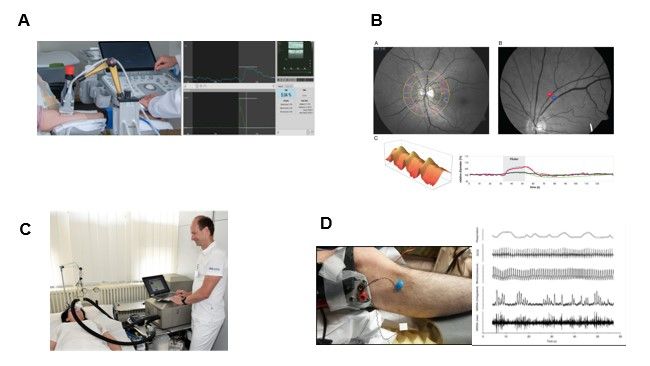Research Group: Vascular Function & Volume Regulation (Group leaders: Prof. Dr. med. Isabella Sudano; Prof. Dr. med. Andreas Flammer)
The research lab focus on blood volume regulation and endothelial function, combining gold standard methods with new and innovative research approaches. This opens up new perspectives to explore the vasculature in relation to health, disease and therapy in different vascular beds. Particularly the impact of inflammation, cardiovascular risk factors and heart failure and the consequences of interventions with medications and nutrition (or its compounds) are studied. A recent highlight was the interdisciplinary description of endotheliitis and endothelial inflammation in patients with COVID-19 – published as a research letter in the Lancet with over 3000 citations so far.
Beside the established methods to invasively- and non-invasively measure endothelial function (e.g. flow mediated dilatation – FMD, Figure 1A) we established – with the support of the SNSF and other competitive grants – a novel technique for the measurement of endothelial function in our lab. With the “retinal vessel analyzer, Figure 1B” we are able to non-invasively and accurately study vascular function in the retinal arterioles and veins via flicker-light induced endothelial dependent vasodilation and neurovascular coupling. We now have a huge armamentarium to study endothelial function in several ways to assess cardiovascular risk, early atherosclerosis and to estimate prognosis. Further, pulse wave analysis (PWA), as a measure of arterial stiffness, and the sonographic assessment of the intima-media thickness of the carotid arteries help to assess the vasculature structurally.
Sympathetic activation is crucial for regulation vascular tone. In our lab we are able to assess sympathetic nervous activation directly in the peroneus nerve by microneurography (Fig. 1D) – to study its role in physiological and pathological conditions.
Further, blood volume regulation is to a big extent regulated by the vasculature. In this context, we measure blood volume using the carbon monoxide rebreathing method (Fig. 1C), combined with bioelectrical impedance analysis. This non-invasive, safe and easy-to-use method allow us determining blood volume and its components (e.g. plasma volume, total hemoglobin mass, red blood cell volume).

Figure 1.
A Measurement of endothelial function by Flow-mediated dilatation;
B Evaluation of the dynamic and static microvascular function of the retinal vessels by retinal vessel analysis;
C Measurement of blood volume by carbon monoxide rebreathing method;
D direct measurement of sympathetic nervous system activity by microneurography.
Ongoing research lines
- Evaluation of micro-and macro-circulation in patients with cardiovascular risk factors, overt cardiovascular diseases and healthy subjects
- Evaluation of the effect of opioids and painkiller on vascular function and sympathetic nervous activity
- Evaluation of vascular function and blood volume in patients with acute and stable heart failure
Research Team
- Valentina Rossi, MD
- Natallia Laptseva, MD
- Thomas Haider, MD
- Anne-Marieke Vegter, RN
Funding
- Swiss National Science Foundation
- Schweizerische Herzstiftung/Swiss Heart Foundation
- Schwyzer-Winiker-Stiftung
- Gottfried und Julia Bangerter-Rhyner-Stiftung
- Freenovation Grant by Novartis Foundation
- Zampiccoli E, Barthelmes J, Kreysing L, Nägele MP, Nebunu D, Haider T, von Eckardstein A, Gerber B, Schwotzer R, Ruschitzka F, Sudano I, Flammer AJ. Eyes on amyloidosis: microvascular retinal dysfunction in cardiac amyloidosis. ESC Heart Fail. 2022 Apr;9(2):1186-1194.
- Montero D, Haider T, Nägele MP, Barthelmes J, Cantatore S, Sudano I, Ruschitzka F, Bonani M, Flammer AJ. Effects of hemodialysis on blood volume, macro- and microvascular function. Microvasc Res. 2020 May;129:103958.
- Montero D, Haider T, Barthelmes J, Goetze JP, Cantatore S, Sudano I, Ruschitzka F, Flammer AJ. Hypovolemia and reduced hemoglobin mass in patients with heart failure and preserved ejection fraction.
Physiol Rep. 2019 Nov;7(21):e14222 - Barthelmes J, Nägele MP, Cantatore S, Novruzov E, Ludovici V, von Eckardstein A, Frank M, Ruschitzka F, Sudano I, Flammer AJ. Retinal microvascular dysfunction in patients with coronary artery disease with and without heart failure: a continuum? Eur J Heart Fail. 2019 Aug;21(8):988-997
- Nägele MP, Barthelmes J, Ludovici V, Cantatore S, Frank M, Ruschitzka F, Flammer AJ, Sudano I.J Retinal microvascular dysfunction in hypercholesterolemia. Clin Lipidol. 2018 Nov-Dec;12(6):1523-153
- Nägele MP, Barthelmes J, Ludovici V, Cantatore S, von Eckardstein A, Enseleit F, Lüscher TF, Ruschitzka F, Sudano I, Flammer AJ. Retinal microvascular dysfunction in heart failure. Eur Heart J. 2018 Jan 1;39(1):47-56
- Naegele, M., A. J. Flammer, F. Enseleit, S. Roas, M. Frank, A. Hirt, P. Kaiser, S. Cantatore, C. Templin, G. Frohlich, M. Romanens, T. F. Luscher, F. Ruschitzka, G. Noll and I. Sudano. “Endothelial function and sympathetic nervous system activity in patients with Takotsubo syndrome.” Int J Cardiol 2016 224: 226-230.
- Flammer AJ, Sudano I, Wolfrum M, Thomas R, Enseleit F, Périat D, Kaiser P, Hirt A, Hermann M, Serafini M, Lévêques A, Lüscher TF, Ruschitzka F, Noll G, Corti R. Cardiovascular effects of flavanol-rich chocolate in patients with heart failure. Eur Heart J. 2012 Sep;33(17):2172-80
- Sudano I, Flammer AJ, Périat D, Enseleit F, Hermann M, Wolfrum M, Hirt A, Kaiser P, Hurlimann D, Neidhart M, Gay S, Holzmeister J, Nussberger J, Mocharla P, Landmesser U, Haile SR, Corti R, Vanhoutte PM, Lüscher TF, Noll G, Ruschitzka F. Acetaminophen increases blood pressure in patients with coronary artery disease. 2010 Nov 2;122(18):1789-96.